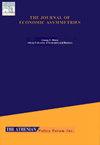债务整合战略下的财政不对称:来自哥伦比亚的证据
Q1 Economics, Econometrics and Finance
引用次数: 0
摘要
本文开发并实施了针对哥伦比亚这一小型开放型新兴经济体的财政DSGE模型。本研究的重点是在这种背景下财政整顿策略的不对称效应。该模型是作为新凯恩斯主义DSGE框架构建的,使用贝叶斯技术对哥伦比亚经济和相关外部变量的特定数据进行估计。它包括异质家庭(李嘉图和非李嘉图)、国内最终产品和中间产品生产商、进口商、出口商,以及负责财政政策的国家政府和负责货币政策的中央银行。关键的摩擦,如消费习惯的形成,资本存量的利用,风险调整后未发现的利率平价,以及价格和工资的刚性也包括在内。结果表明,财政乘数根据所使用的财政工具而有显著差异,削减支出对产出的收缩作用比增加税收更大。此外,整顿措施严重影响了非李嘉图家庭,加剧了收入不平等。该模型突出了财政不对称,表明在财政整顿下,更依赖公共支出的部门将面临收缩。这些发现为了解国有企业财政和货币政策的动态提供了有价值的见解,并为哥伦比亚等新兴市场的政策分析和经济预测提供了重要工具。本文章由计算机程序翻译,如有差异,请以英文原文为准。
Fiscal asymmetries under a debt consolidation strategy: Evidence from Colombia
This paper develops and implements a fiscal DSGE model tailored to Colombia, a small and open emerging economy (SOEE). The study focuses on the asymmetric effects of fiscal consolidation strategies in this context. The model, constructed as a New-Keynesian DSGE framework, is estimated using Bayesian techniques with data specific to the Colombian economy and relevant external variables. It includes heterogeneous households (Ricardian and non-Ricardian), domestic producers of final and intermediate goods, importers, exporters, and a national government responsible for fiscal policy and a central bank responsible for monetary policy. Key frictions such as the formation of consumption habits, capital stock utilization, risk-adjusted uncovered interest rate parity, and price and wage rigidities are also included. The results suggest that fiscal multipliers vary significantly depending on the fiscal instrument used, with spending cuts having a more contractionary effect on output than tax increases. Moreover, consolidation measures fall severely on non-Ricardian households, exacerbating income inequality. The model highlights fiscal asymmetries, showing that sectors more dependent on public spending face contractions under fiscal consolidation. These findings provide valuable insights into the dynamics of fiscal and monetary policy in SOEEs and serve as an important tool for policy analysis and economic forecasting in emerging markets such as Colombia.
求助全文
通过发布文献求助,成功后即可免费获取论文全文。
去求助
来源期刊

Journal of Economic Asymmetries
Economics, Econometrics and Finance-Economics, Econometrics and Finance (all)
CiteScore
4.80
自引率
0.00%
发文量
42
审稿时长
50 days
 求助内容:
求助内容: 应助结果提醒方式:
应助结果提醒方式:


